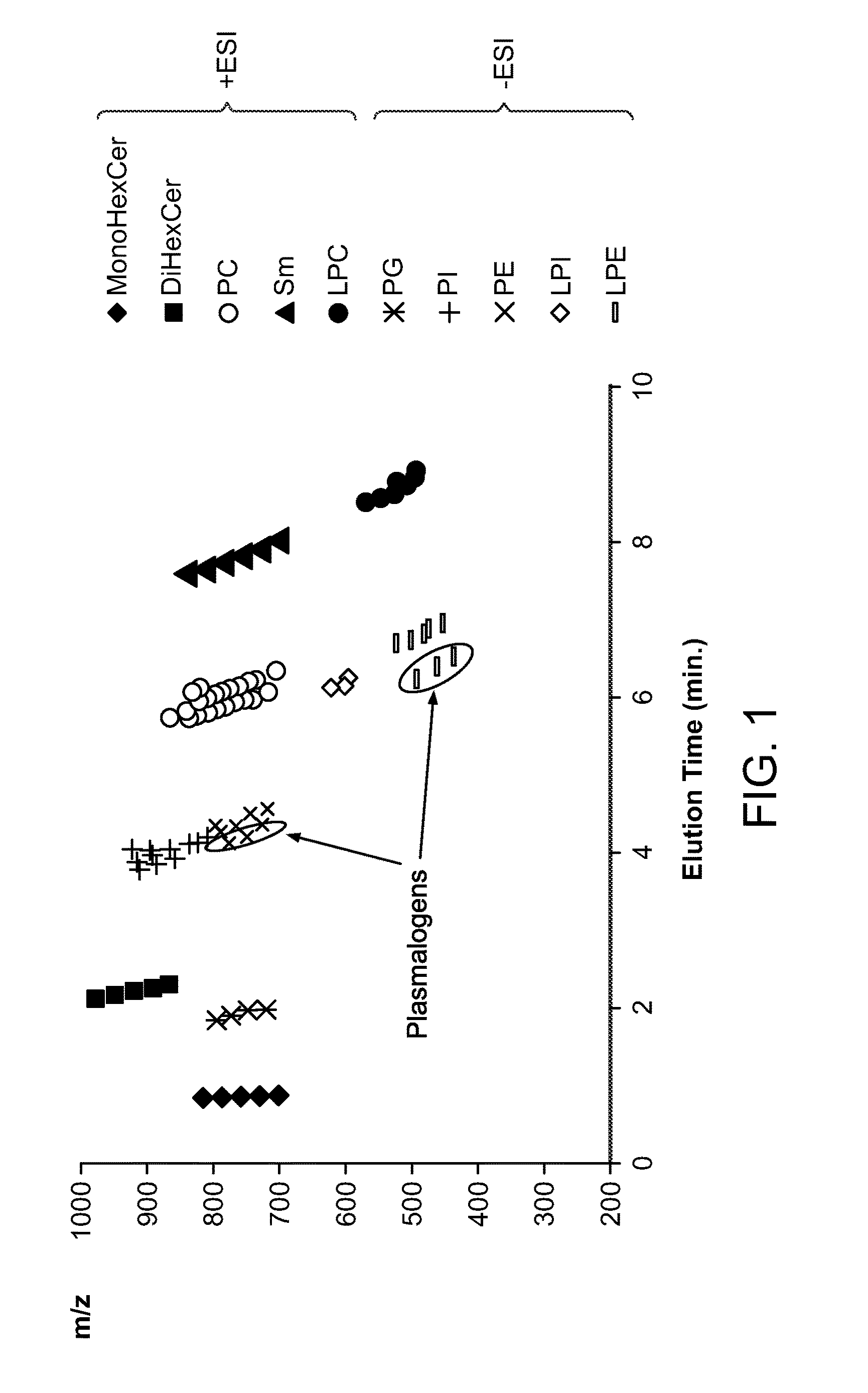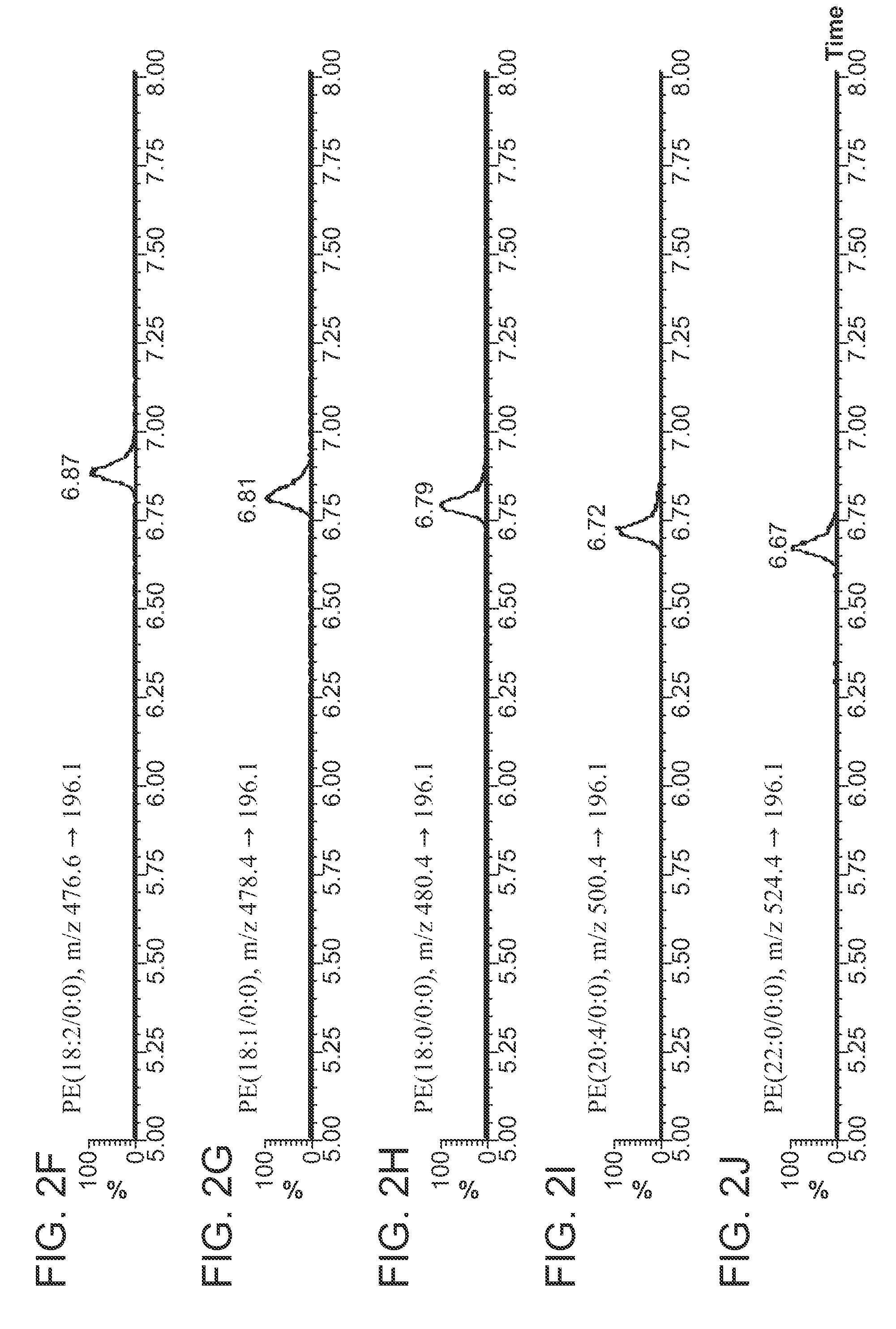Methods of separating lipids
a technology of lipids and lipids, applied in the field of methods of lipid separation, can solve the problems of limited progress in understanding the exact role and action of plasmalogens, and analytical challenges, and achieve the effect of simple, reliable and effectiv
- Summary
- Abstract
- Description
- Claims
- Application Information
AI Technical Summary
Benefits of technology
Problems solved by technology
Method used
Image
Examples
example 1
General Methods and Systems
a) Chemicals
[0141]Acetonitrile and isopropanol (Optima LC / MS Grade) were obtained from Fisher Scientific (Fair Lawn, N.J.). Ammonium acetate (LC-MS Ultra, Fluka), ethanol, and citrated human plasma were obtained from Sigma-Aldrich (St. Louis, Mo.). Phospholipid standards were obtained from Avanti Polar Lipids (Alabaster, Ala.). Deionized water (>18 MΩ) was produced in-house using a Milli-Q water purification system (Millipore, Bedford, Mass.) fitted with a LC-Pak™ C18 cartridge on the outlet.
[0142]100 μL of human plasma was loaded into each well of an Ostro sample preparation plate designed for selective binding of phospholipids (Waters Corp, Milford, Mass.). 800 μL of ethanol was added to each sample and mixed thoroughly by repeated aspiration using a micropipette. The mixture was drawn through the plate under 15″ Hg vacuum and collected. This step was repeated with the further addition of 800 μL of ethanol and the fractions combined as...
example 2
Lipid Separation from Human Plasma
[0154]Phospholipids were extracted from 100 μl of human plasma using Ostro. Briefly, plasma was drawn through an Ostro 96-well plate (Waters P / N: 186005518) with 2×800 μL of ethanol and the flow through containing ceramides, PEs, PIs and PGs collected. PCs and SMs were extracted by adding 2×800 μL of 4.5:4.5:1 (v / v / v) chloroform / methanol / triethylamine to the plate and collecting the eluate. Both fractions were dried and reconstituted with 200 μL 1:1 (v / v) chloroform / methanol.
[0155]The following separation conditions were employed:
[0156]LC Conditions:
[0157]LC System: ACQUITY UPLC® System (a UHPLC system)
[0158]Column: ACQUITY BEH HILIC 1.7 μm, 2.1×100 mm
[0159]Column Temp.: 30° C.
[0160]Mobile Phase A: Acetonitrile / Water (95:5) with 10 mM Ammonium Acetate, pH 8.0
[0161]Mobile Phase B: Acetonitrile / Water (50:50) with 10 mM Ammonium Acetate, pH 8.0
[0162]Gradient: 0-20% B / 10 min
[0163]Flow Rate: 500 μL / min
[0164]MS Conditions:
[0165]MS System: Xevo™ TQ-S
[0166]...
example 3
Separation of Sphingomyelins (SMs) and Phosphatidylcholines (PCs)
[0183]Identification of lipids can be performed, based on precursor masses and the corresponding fragment or neutral loss characteristic of each group of lipids. However, some groups, such as the PCs and SMs not only produce characteristic fragments of the same mass (m / z 184.0738), but they are also only separated by 1 Da, and hence their isotopes interfere with the detection and quantification of one another. This is an issue with direct infusion where there is no separation of the different lipid classes, and is also true for RP-LC separations, where the lipid classes overlap, as illustrated in FIG. 5a.
[0184]Class-distinct separation can be achieved by normal-phase HPLC methods, but typically require about an hour for efficient separation (Shui G et al., PLoS One 2010, 5:e11956). Thus, a ‘normal-phase’-like method providing effective separation of different lipid classes on UHPLC timescales (about 10 minutes) is hig...
PUM
| Property | Measurement | Unit |
|---|---|---|
| pH | aaaaa | aaaaa |
| flow rate | aaaaa | aaaaa |
| temperature | aaaaa | aaaaa |
Abstract
Description
Claims
Application Information
 Login to View More
Login to View More - R&D
- Intellectual Property
- Life Sciences
- Materials
- Tech Scout
- Unparalleled Data Quality
- Higher Quality Content
- 60% Fewer Hallucinations
Browse by: Latest US Patents, China's latest patents, Technical Efficacy Thesaurus, Application Domain, Technology Topic, Popular Technical Reports.
© 2025 PatSnap. All rights reserved.Legal|Privacy policy|Modern Slavery Act Transparency Statement|Sitemap|About US| Contact US: help@patsnap.com



